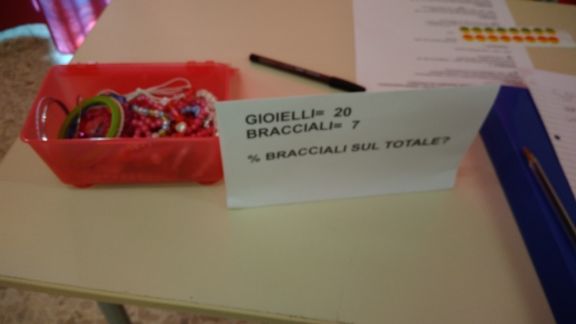General Info
The activity was proposed to make mathematics live in a real situation. The theme on which the activity is focused is the percentage. The pupils created problems in working groups that subsequently proposed and solved in the lecture hall, where we simulated a market with stalls. The activity was very demanding and involved all the pupils for 20 days, during the current school year.
Audience and Educational Framework
Educational Details
The experimental activity was developed starting from an input provided by a new disabled pupil, who showed interest in the percentages. The teacher planned a reality task, in which mathematics was applied to a real situation that the pupil could live in a market. The pupils created the problems to be submitted to their classmates in work groups, according to the typology indicated by the teacher. The pupils played both the role of sellers and buyers, in a market where stalls with different types of goods were placed. At each stall, the pupils observed the goods and solved the problems that their classmates proposed. The exact resolution of the same, allowed to obtain a stamp to be pasted on a card, which at the end the teacher evaluated. The experience was very positive, because the pupils understood the usefulness of knowing the percentages, as they are necessary to solve problems of daily life. The collaboration between pupils has been very positive, as has the integration of pupils in difficulty and the disabled. The assessment of pupils' performance was better than the previous traditional verification previously carried out on the same topic.
Goals for skills development (National Indications)
The student has strengthened a positive attitude towards mathematics and, through experiences in significant contexts, has understood how learned mathematical tools are useful in many situations to operate in reality;
The pupil respects points of view different from your own; agrees to change his mind by recognizing the logical consequences of a correct argument;
The pupil recognizes and solves problems by analyzing the situation and translating into mathematical terms, and solves problems of various kinds, keeping control both on the solution process and on the results.
Specific learning objectives
The pupil performs additions, subtractions, multiplications, divisions and percentages:
Phases of the activity
Division of pupils into heterogeneous working groups within them;
Definition of the typology of exercises to be created;
Exercise creation and resolution;
Organization of stalls setting up;
Real life simulation in a market;
Evaluation of the exercises solved by each pupil.
Word. Google drive. Power point.

Implementation
(where and how the practice was implemented)
The activity took place in 10 hours (October-November 2019).
DIVISION OF PUPILS INTO HETEROGENEOUS WORKING GROUPS WITHIN THEM (1 hour)
The pupils were divided into four groups, whose components had different levels of competence in mathematics. The two disabled pupils also participated and collaborated within the groups. Previously I had had a check on the percentages, the results of which were disappointing, therefore I thought of proposing the topic in a different way. The pupils chose the goods to sell and imagined how to set up the stalls.
DEFINITION OF THE TYPE OF EXERCISES TO BE CREATED (1 hour)
The teacher proposed 6 types of exercises on the application of direct and inverse formulas.
In working groups, the pupils identified the goods to be sold and they connected a specific object with a specific exercise.
EXERCISE CREATION AND RESOLUTION (4 hours)
This phase was the most complex and difficult, because it involved the correct use of specific language. The pupils showed me the texts of the exercises and based on my suggestions, they have been improved to be easily understandable to everyone. We have dedicated 4 lessons to writing the texts of the exercises.
Subsequently, after the teacher approved each group's exercises, the pupils solved their exercises.
The solved exercises were handed over to the teacher who corrected the resolutions, pointing out the errors in some cases.
ORGANIZATION OF STALLS SETTING UP (1 hour)
The pupils went on to plan the setting up of the stall. The items to bring were divided, they created the signs with the indications of the exercises to be solved and they elaborated a personal sheet
in which to glue the stamps that they would have received after the resolution of each exercise.
REAL LIFE SIMULATION IN A MARKET(2 hours)
On the day of the experimentation, the teacher arranged the desks in the lecture hall and then the pupils arranged themselves in the four positions, on which they placed objects and signs.
In turn, they performed the function of seller and buyer, proposing the exercises to their classmates and solving them at their choice, so that each type of problem was solved.
EVALUATION OF THE EXERCISES SOLVED BY EACH PUPIL (1 hour)
If the exercise had been carried out correctly, the pupil received a stamp of a certain color, depending on the number of the exercise and this stamp was marked with an x if it was not correct. At the end, whoever made mistakes, could solve an exercise, called Jolly, to improve his score. When a pupil finished the tour of the boats, he took turns with a pupil of his stall and became the seller. At the end, the teacher checked the cards with the stickers of each pupil to verify their score and which exercises had been carried out incorrectly. Almost all pupils did the exercises correctly and the pupils' performance was far better than the previous traditional written one. It was a very positive day that raised the curiosity of the school teachers and the headmaster, who wanted to see the activity.
Educational material/resources (file/URL) accompanying the practice
Italian